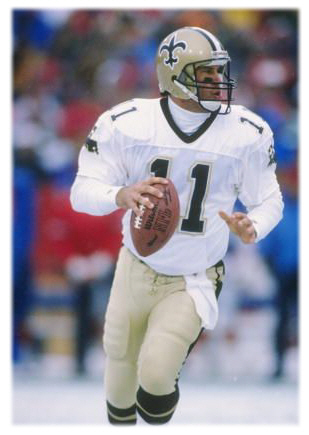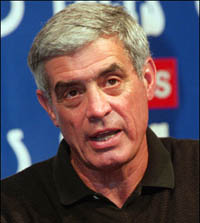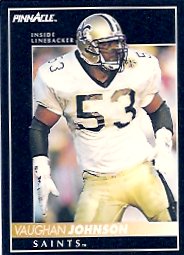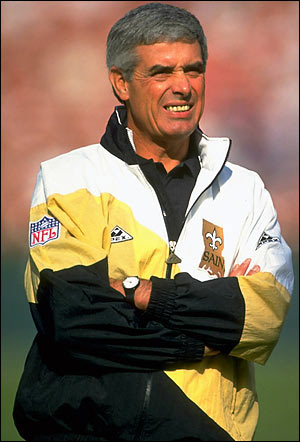
John Mecom, Jr. with Pete Rozelle
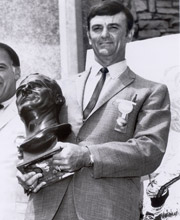
Tom Fears
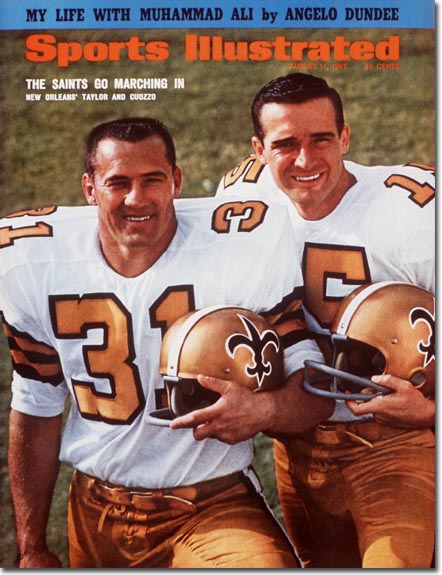
Jim Taylor and Gary Cuozo
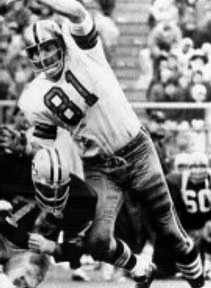
Doug Atkins |
Saints' First Draft
After years of work by New Orleans businessman Dave Dixon and his associates and the promise of a domed stadium should New Orleans be granted a team, the NFL awarded its 16th franchise to New Orleans on All-Saints Day, November 1, 1966.
- In mid-December, 28-year-old John Mecom, Jr., a Texas oilman, becomes the club's majority stockholder-president.
- Tom Fears, Hall of Fame WR for the Los Angeles Rams, is hired as the first coach.
- The Saints are placed in the Capitol Division of the Eastern Conference with the Dallas Cowboys, Philadelphia Eagles, and Washington Redskins.
- The team sells 20,000 season tickets the first day they were available. Eventually, the number reaches 33,400 by the time the inaugural season begins.
The Saints stocked their roster via the expansion draft as well as the regular college player draft. The only free agents available were players who had been released by their former clubs since in those days drafting a player gave the club exclusive rights until the team cut him.
- Director of Player Personnel Jim Schwenk oversaw the expansion draft on February 9.
- Since Atlanta had just entered the league the year before, it was exempt. However, each of the other 14 teams had to offer 11 players from its roster. After the Saints selected a player from a team, that club could then pull two players off the list. Then New Orleans chose two more players from each team for a total of 42. "The other teams put every 'dog' they could on that list," said Saints D-coordinator Jack Faulkner. "A lot of those guys didn't stay around very long, and most of them didn't contribute very much."
- The team chose 36 more players from the first common college draft held by the newly merged National and American Football Leagues.
- The Saints were granted the first and last pick in each round, an excellent opportunity to take players who could contribute to the club for years to come.
However, the front office immediately demonstrated the ineptitude that would plague the franchise for decades.
- The club traded the #1 pick in the draft to the Baltimore Colts for their backup QB Gary Cuozzo. (The Colts took Bubba Smith, future Pro Bowl DE from Michigan State, with the initial pick.)
- When N.O. finally chose a player at the end of the round, it was RB Les Kelley of Alabama, whom no one had rated that high. Then with the first pick of the second round, they selected Bo Burris, DB from Houston.
- Neither Kelley, who was moved to LB, nor Burris contributed significantly to the team.
- With the last two picks of the second round, the Saints did take WR John Gilliam from South Carolina State and DT Dave Rowe from Penn State. Both proved to be good players, although the Saints traded Gilliam to the St. Louis Cardinals after two seasons.
When the smoke cleared, the Saints' roster boasted three future Pro Football Hall of Famers. However, only one of them contributed much on the field.
- FB Jimmy Taylor was taken from Green Bay, where he had been a key cog on five Packer championship teams. Unfortunately, Jimmy's hard-running style had worn him down to the point where he retired after only one season in his native Louisiana where he had starred for LSU.
- Packers' coach Vince Lombardi "generously" contributed his other star RB, Paul Hornung, to the expansion draft. Hornung, plagued by injuries for several years, retired because of a bad back without ever playing a down for the Saints.
- DE Doug Atkins came to New Orleans via a trade with the Chicago Bears. A four-time Pro Bowler, Doug played two seasons with the Saints before retiring.
So a ragtag team of over-the-hill veterans, never-wases, and rookies took the field for the Saints' first game. But that's a story for another day.
|
Dazzling Debut: Archie Manning
|
September 19, 1971 - Tulane Stadium, New Orleans LA
With the second pick in the 1971 NFL Draft, the New Orleans Saints took Ole Miss QB Archie Manning. That was the draft in which the first three choices were QBs: #1 Jim Plunkett to the Patriots and #3 Dan Pastorini to the Houston Oilers.
- Saints nation was excited by the selection. T-shirts that said "Archie is No. 1," "Archie is our boy,"
or "Archie is a Saint"
sold like hotcakes.
- Since veteran QB Billy Kilmer
was traded to Washington
in the off-season, Manning started in his very
first regular season game in Tulane Stadium against the Los Angeles Rams.
- Archie was not the only young Saint on the opening day roster. As he said in the book, The Football Game I'll Never Forget, Not one guy on the squad was older than 30. In fact, we had 13 rookies on the roster, and many other players were in their second or third seasons.
The late summer Crescent City heat almost did Archie in before the game began.
- Manning recalled: They'd just installed turf in Tulane Stadium, and it must have been about 130 degrees on the field.
- He always did his stretching before each game but also decided on some extra pregame sprints in anticipation of running for his life behind the Saints' weak offensive line.
- Manning: I went to the locker room after warmups and told Danny Abramowicz that I didn't think I could go. I had not one ounce of energy left. I felt like I was about to pass out. I was scared to death.
- Danny told his new quarterback to change his clothes, drink some liquids, and cool off. After that, the adrenaline got me pumped up again, and I was all right, Manning said.
A
lackluster first half ended 3-3.
- Veteran QB Roman Gabriel,
suffering from bruised ribs, was only 4-for-16. However, rookie
coach Tommy Prothro never considered replacing
him even when the Saints jumped out 17-3 in
the third.
- The touchdowns came on Archie's 6y
pass to WR Dave Parks and a 1y plunge
by Bob Gresham.
The Ram offense finally got into gear late in the third quarter.
- After a 66y touchdown run by Willie Ellison was called
back for clipping, LA settled for a David Ray field goal.
- Then Gabriel
finally came alive in the last stanza with a 29y touchdown to RB
Les Josephson to cut the deficit to 17-13.
- The visitors seemed to have the game won when they took a 20-17
lead with 4:57 on a 1y plunge by Josephson
and rookie Skip Butler's 48y tying field goal
went wide with 1:55 left.
- However, the Saints, using their timeouts, forced a punt, and Archie had another shot
from his 30 with 1:24 on the clock.
- If Archie was to lead a comeback, he needed help, and he got it from an unlikely source.
Rookie RB Bob Gresham from West Virginia had carried the ball just once in the six preseason games and was lucky to make the taxi squad the Thursday before the opening game.
- But he was activated at the 11th hour Saturday when it became apparent that Tony Baker wouldn't be able to go because of injury.
- Gresham carried 21 times for just 42y on the day. But he made a crucial play on the Saints' first possession of the second half. On 3rd down from inside the LA 20, Manning's pass was deflected at the line of scrimmage and soared high into the air into the arms of Marlin McKeever. But gritty Gresham muscled the ball away from the LB to make it 1st-and-goal from the 3. Three plays later, Archie hit Parks in the end zone to break the 3-3 tie.
Gresham made an even bigger contribution on the first play of the do-or-die final drive.
- The Rams paid no attention to him when he circled out of the backfield. So Archie threw to him for a 37y gain to the LA 33.
- After an incompletion, Manning crossed up the defense by calling a draw play to FB Hoyle Granger to the 25 with 0:47 left.
- Manning-to-Abramowicz gained a dozen more with 35 ticks to go.
- Granger got three on a short toss.
- The clock stopped with 23 seconds showing after Manning missed Danny in the corner of the end zone. But wait. A flag. Jim Nettles was called was interference. 1st down at the one!
- RB Jim Ford tried to ram in over the right side but met a stone wall.
- Manning overthrew Abramowicz in the end zone to run the time down to 0:03.
Coach J. D. Roberts decided to disdain the easy field goal for the tie in those days before overtime.
- Manning: J.D. Roberts just kept saying "We're gonna go for it." One of the assistants said we should do this and another said we should do that and the next thing I knew, the ref was tapping me on the shoulder and telling me time was up. And they hadn't even called a play. Danny met me about halfway to the huddle and asked what they called, and I told him they hadn't called anything. So I called a little bootleg rollout.
- As Archie took the snap and rolled left, I told myself that I couldn't throw it. I had to run it. I put my head down and bowled into the end zone, with the ball coming loose at one point. As he lay in the end zone, I thought to myself, "You can't take this touchdown away from us." We had worked too hard and come too far to lose like this. When the nearest
official raised his arms, 70,915 went wild.
As jubilant fans ran onto the field, the Rams
vigorously disputed the touchdown.
- DE Deacon Jones bellowed:
A blind man could do a better job. Manning
was on the one and dropped the ball on the way down. ... Jack
Youngblood recovered on the one.
- Archie said after the game: I fumbled the ball, but I hit the ground first. That's
a real tough call for an official. Today, of course, the play would be reviewed.
- The officials finally cleared the field so that Skip Butler could kick the PAT to make the final score 24-20.
- Manning years later: So, was it really a touchdown? Did I fumble before I crossed the goal line? I honestly don't know and, looking back, I don't really care.
Bob Roesler started his article on the game in the Times-Picayune the next day like this.
Yes, America, there is a superman.
His name is Archie Manning and he wears a Saint uniform.
Sunday this miracle man gave New Orleans a 24-20 victory over Los Angeles.
It was absolutely fantastic, unbelievable. It was Archie Manning at his absolute best when he was needed the most.
Later that year, Archie engineered an upset of the Cowboys in Dallas, 24-14. Overall, the season was a disappointment: 4-8-2.
Reference: War Stories from the Field, Joseph Hession & Kevin Lynch (1994)
The Football Game I'll Never Forget, Chris McDonell (2004)
|

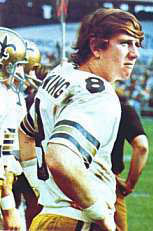
Archie Manning 1971 and in action vs Rams below
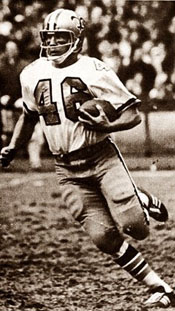
Danny Abramowicz
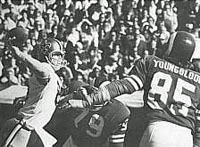
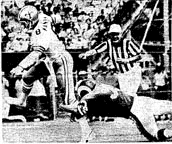

Bob Gresham
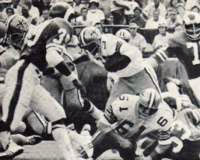
Gresham runs against Rams
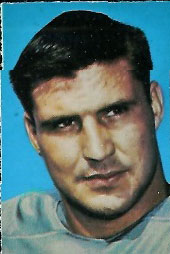
Hoyle Granger
|
Dazzling Debut: John Fourcade
|
Growing up in New Orleans, John Fourcade dreamed of one day QBing the Saints. He finally made it after he had retired from pro football. It took a player strike to make it happen.
After an All-State career at Archbishop Shaw High School, Fourcade played four years at Ole Miss (1978-81) where he broke many of Archie Manning's records. However, no team drafted him because of his size (5'11") or his reputation for being undisciplined and cocky. So John began an odyssey that took him to four cities in three different leagues.
- He signed with the British Columbia Lions of the Canadian Football League. He played four games as a backup in 1982.
- 1983 found him with the CFL's Winnipeg Blue Bombers.
- The next season, he joined the Birmingham Stallions of the new United States Football League.
- Then he played for the USFL's Memphis Showboats in 1984 and 1985, the league's final campaign.
- Fourcade signed with the Saints as a free agent before the '86 season but was cut by first-year coach Jim Mora after only five days. At that point, the vagabond QB figured his football days might be over.
- He returned to Ole Miss to complete his degree until May 1987 when he returned to the CFL with the Toronto Argonauts. However, he lasted only five days again.
- Then another league beckoned – the Arena Football League. John QBed the Denver Dynamite during their stretch drive to the first Arena Bowl championship.
- In August 1987, he accepted a teaching/coaching position at John Ehret High School back at his West Bank stomping grounds in the Crescent City.
It was at this point that larger forces intervened to give John another shot with the Saints.
- After two weeks of the 1987 regular season, the NFL Players Association called its second strike in six years.
- Unlike 1982, when nearly half the schedule was cancelled, the owners were ready with plans for "replacement" teams.
- Once the strike was called, Mora and his staff contacted released players and free agents in addition to a small number of veteran players who decided not to honor the strike.
- Fourcade was on his way to the airport to fly to Los Angeles to try out for the Raiders when the Saints called. The chance to QB his hometown team made his decision to change his plans a no-brainer.
After the Week Three games were cancelled, the schedule resumed with Week Four. The Saints hosted the Los Angeles Rams before 29,745 – one of the largest crowds in the league that day.
- Fourcade directed a Q1 17-play drive that ended with his first NFL touchdown pass for a 7-0 Saints lead.
- John threw another scoring pass in Q2, this one 11 yd to Eric Martin, one of 14 regular New Orleans players to defy the union.
- Still in Q2, the former Rebel engineered a 12-play drive to give the Saints a 27-0 halftime lead.
- Fourcade capped the afternoon in Q4 with an 82-yd touchdown pass to TE Mike Waters - the longest scoring pass in team history. The final score was 37-10.
- John's final stats read 16-21 for 222 and three touchdowns. The Saints converted 14 of 18 third downs.
The replacement teams played two more weeks.
- Fourcade played well at St. Louis but the Cardinals prevailed 24-19.
- On the Thursday before the next game, the NFLPA threw in the towel and announced the end of the work stoppage. The strikers would return to their teams after the third replacement weekend.
- After fallling behind to the Bears in Chicago 17-3, the Saints rallied behind Fourcade. He hit Martin with a 14-yd touchdown strike to cut the gap to 17-10 at the half. The D held Chicago scoreless in the second half while three Florian Kempf field goals gave New Orleans a 19-17 triumph.
Fourcade was one of four replacement players who remained on the Saints roster when the veterans returned. The '87 squad went on to make the first playoff appearance in franchise history. After appearing in only one game in '88, he played in 13 in 1989 as backup to Bobby Hebert. Seven more games in '90 finally ended John's NFL career.
|
One name guaranteed to make long-time Saints fans wince and curse is Russell Erxleben. Erxleben, Jerxleben. He epitomizes the bad management of the team for the first 15 years of the franchise.
At Texas from 1975-78, Erxleben had arguably the greatest kicking career in the history of college football.
- Russell was the only three-time All-American punter in NCAA history.
- He set the record for the longest field goal in history with a 67-yarder against Rice in 1977. UTcoach Fred Akers said: "It was like a gunshot. We couldn't believe a ball was going that far." Interestingly, Steve Little of Arkansas, another Southwest Conference school, tied Erxleben's record two weeks later.
- Russell kicked two other 60+ yd field goal that season. In response to these bombs, the NCAA changed several rules for the 1978 season, prohibiting the use of a tee on place kicks and marking the ball at the line of scrimmage instead of the 20 after missed field goals from beyond the 20.
- SMU coach Ron Meyer called Erx "the greatest kicker in the history of college football."
Attracted by the prospect of filling two kicking positions with one player, the Saints drafted Erxleben in the first round of the 1979 draft. He thus joined Charlie Gogolak and Ray Guy as the only punters/kickers taken in Round One. (Sebastian Janikowski has since joined the club.) However, Erxleben's selection at #11 remains the highest any kicker has ever been taken.
The Saints signed Erx to a multi-year contract that reportedly made him the first $1,000,000 kicker in history. The media and many fans questioned the Saints' judgment, and it didn't take long for Russell to give his critics plenty of ammunition.
- Here is Sports Illustrated's description of Russell's first kick in a scrimmage for the Saints.
The date: July 28. The site: Dodgertown, the Vero Beach, Fla. training complex used by the Saints, who this day are scrimmaging Miami. With a fourth down at the Dolphins' 28-yard line, New Orleans Coach Dick Nolan calls for a field goal. The distance: 45 yards. A fairly prodigious kick for most, but certainly a mere chip shot for the rookie they call "Thunderfoot." Blare of trumpets. Roll of drums.
The crowd quiets. Center Mark Meseroll crouches over the football. The snap darts back to the holder, Ed Burns, who places it carefully on the turf, laces pointing toward the distant goalpost. Erxleben steps forward. For a split second he seems to hesitate, then his powerful right leg swings toward the football. Surely somewhere out there a representative of the Hall of Fame is waiting to claim this pigskin for posterity. The ball soars upward. Then, like a wounded duck, it flutters helplessly and dives back to the ground, not 15 yards from the line of scrimmage. Cut. CUT!
Such was the inauspicious debut of Russell Erxleben, kicking star. Afterward, he described it as "the most embarrassing moment of my life." And, much to his chagrin, the embarrassing moments have not stopped. Erxleben has often said that the hallmark of a great kicker is consistency. Well, this summer he has been consistently horrible.
In the Saints' first exhibition, also against the Dolphins, Erxleben, who placekicks in the old-fashioned straight- ahead style, missed his two field-goal tries, from 32 and 35 yards. And he shanked a punt 19 yards to set up the deciding touchdown in Miami's 14-7 win. In New Orleans' second exhibition, a 13-6 loss to the Chicago Bears, Erxleben had an extra-point attempt blocked and punted three times for a measly 32-yard average. He also kicked off once, but only to the 11-yard line. Still, that was a seven-yard improvement over his lone kickoff the previous week.
- Despite strong evidence that the pressure of his first round status had made Erxleben a basket case, the Saints ignored suggestions to let incumbent Rich Szaro handle the placekicking so that Erx could concentrate on punting.
- In his very first regular season game against the Falcons in the Superdome, Erxleben made both his field goals to help send the game into OT. However, nine minutes into the extra period, the snap from punt formation sailed over his head to the 5. When he picked it up, he made a hurried chest pass into the hands of defender James Mayberry, who waltzed into the end zone to win the game.
- To make matters worse, Erx was injured on the play and never appeared in another game that season.
- 1980 started poorly for Russell also. In the opener against the 49ers, he missed a makeable field goal near the end that would have tied the game. Instead, the Saints lost 26-23 on their way to 14 straight defeats and a 1-15 record.
- For the 1980 campaign, Erx punted for only a 39.5 average and made only two of five field goal as the team entrusted most of the placekicking to Benny Ricardo.
- 1981 saw Russell raise his punting average only one yard, to 40.5. He didn't try a single field goal.
- 1982: Punting average up to 43.0; missed one makeable field goal from 20-30 yards. The Saints drafted another placekicker out of Michigan State named Morten Andersen and, by midyear, made him the placement specialist.
- 1983: Erx did all the punting again for a 41.0 average. When his five-year contract expired, the Saints didn't resign him. He appeared in only one more NFL game in 1987 with the Lions.
ESPN's draft guru, Mel Kiper, ranks Erxleben as one of his ten worst draft evaluations in 30+ years.
In 2000, Erxleben was sentenced to 84 months in Federal prison for implementing a scheme to defraud over 500 investors of his Austin-based company.
|
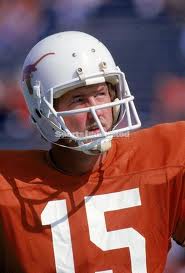 Longhorn
Longhorn Russell Erxleben

Saint Russell Erxleben
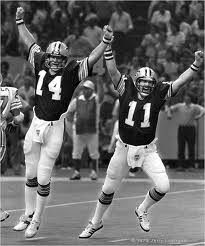
Erxleben and holder Ed Burns celebrate one of Russell's two field goals in 1979
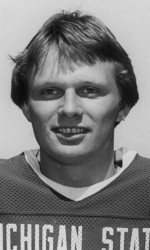
Morten Andersen
|
Those are the immortal words spoken by Saints' second-year coach Jim Mora on October 25, 1987 after his team lost a 24-22 thriller to the San Francisco 49ers in the Superdome to bring New Orleans' record to 3-3. Jim's complete statement went like this.
Could've, would've, should've is the difference in what I'm talking about. The good teams don't say could've, they get it done. They're better than we are. We're not good enough. We shouldn't even be thinking about beating this 49ers team. We shouldn't be talking about it because the Saints ain't good enough.
And you guys shouldn't write about us being a playoff team and all that bullstuff. That's malarkey! We aren't good enough to beat those guys and it was proven out there today. It's that simple: We're not good enough yet. We've got a long way to go; we've got a lot of work to do. We're close, and close doesn't mean bullshit. And you can put that on TV for me.
LB Sam Mills later said: "I think it was something that shook the guys and woke everybody up. It made the guys think, 'Hey, we've gotta get the ball rolling.'" LB Vaughan Johnson agreed. "It did something for the team. It did something for the players too. Coming close doesn't get it. And he made the point ... very clear."
Thus began "the most magical two months in Saints history."
- Mora's team won their final nine games of the season, including a 26-24 victory in San Francisco on November 15. Previously, no Saints squad had ever won more than three in a row!
- However, the 12-3 record wasn't even good enough to win the NFC West as the 49ers finished 13-2.
- Nevertheless, New Orleans made the playoffs for the first time in its history. They hosted the Minnesota Vikings in a wild card game on January 3, 1988.
- Unfortunately, the playoff-hardened Vikings took the crowd out of the game quickly, forging a 33-10 halftime lead on their way to a 44-10 romp. This led some journalists to joke that it had taken the Saints 20 years to make the playoffs, and 20 minues to get out of them.
|
|

Billy Kilmer, UCLA
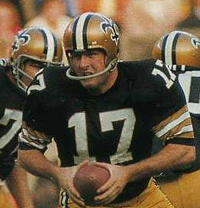
Billy Kilmer, Saints
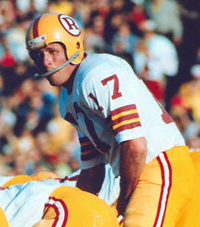
Billy Kilmer, Redskins
|
The Saints' #1 pre- Archie hero was Billy Kilmer, who QBed the club from 1967-70. " Ol' Whiskey," as Kilmer was called by his teammates, had overcome large obstacles to play in the NFL.
- At UCLA he led the nation in total offense as a running/passing single wing TB in his senior season, earning All-American honors. He also played basketball for John Wooden's Bruins. Kilmer finished fifth in the 1960 Heisman voting.
- Billy was the #1 draft choice of San Francisco in 1961. He played sparingly at RB as a rookie but did score four touchdowns against the expansion Vikings.
- He played a larger role in the 49ers' shotgun offense in 1962. However, with two games left in the season, he fell asleep at the wheel on his way home from a hunting trip and crashed into a ditch. He lay unconscious with a broken right ankle for more than an hour. Doctors figured that he would have a permanent limp and would never play football again. They considered amputation because of an infection caused by the stagnant water in the ditch.
- Kilmer missed the '63 season but returned for limited action in '64. He missed all of 1965 and saw spot duty in '66. Not surprisingly, the 49ers made him available for the the '67 expansion draft. Faced with slim pickings, the Saints decided to take a chance on him despite the fact that he had no experience as an under-center QB.
Billy faced an uphill battle to make the Saints roster.
- Starting training camp as the third-string signal-caller, Kilmer worked his way to the opening day starting job with his play in the preseason games. However, he split time with Gary Cuozzo, starting only four contests.
- In Week 10 in a 48-21 loss to Philadelphia, he threw two touchdowns in relief of Cuozzo. He also connected with "Flea" Roberts for a team record 96-yard completion from the Saints' three to the enemy one.
- The following week, coach Tom Fears sent Billy out for the second half with the Saints trailing the Falcons 21-10. He promptly led NO on a 53-yard drive to a touchdown to make the score 21-17. Then, with just over four minutes left in the game, he marched the Saints from their 3 to the game-winning touchdown on a pass to TE Kent Kramer with 48 seconds left. Billy cemented himself as a favorite of the 83,437 fans in Tulane Stadium and countless more listening on the radio.
- Billy relieved again in the final game at Washington after a scoreless Q1. He threw two touchdown passes to Danny Abramowicz, including one of 80y, as the Saints won their third game of the maiden season, 30-14. So satisfied were the Saints with Kilmer's play that they traded Cuozo to Minnesota after the season for two #1 draft choices
- Kilmer started 11 games in NO's second season. He passed for 2,060 yd as the Saints amass a 7-20-1 record over two seasons, the best ever for an expansion team.
- The highlight of 1969 occurred on November 2 in St. Louis. Kilmer engaged in a duel with his Cardinal counterpart, Charlie Johnson. Billy tossed six touchdown passes in the 51-42 victory while Johnson matched him with six of his own. The aerial circus set a record for most touchdown passes in an NFL game as Kilmer won the NFL Player of the Week award.
- Three weeks later in Tulane Stadium, the saga of Billy Kilmer featured another memorable chapter. The Saints trailed the 49ers 21-0 when Kilmer suffered a separated shoulder. Saints assistant Ed Khayat: "We all figured he was done, but he said, 'Hell no! Pop it back into place and get me back out there!" He led the NO comeback, passing for 235 yd and two touchdowns as the Saints won another shootout, 43-38, on their way to a 5-9 record.
- The Saints retrogressed in 1970 to 2-11-1 as Billy started only 10 games. After the season, he was traded to Washington, where he led George Allen's "Over the Hill Gang" to the 1972 Super Bowl.
- He retired in 1978 after a 17-year career.
Kilmer has always had a warm spot in his heart for New Orleans and its fans.
I always loved New Orleans, and I always will. I love the fans and the way they supported the team even when we lost. I used to tell the players, "You don't realize how good you have it here. Put out, work a little harder, win a few games and you'll be kings of Louisiana." I would have loved to have finished the job here and brought a winner here. It would have been Mardi Gras for years.
|
Doug Atkins came to the Saints in the original expansion draft from the Chicago Bears. A mountain of a man from the Tennessee mountains, the 6'8" 270 pounder had incredible strength, as illustrated by this story.
- G Ray Rissmiller, later Adkins' teammate with the Saints, faced him with the Philadelphia Eagles in 1966. Veteran C Jim Ringo cautioned his young teammate.
When you go against Adkins, whatever you do, don't hold him. Because if you do, he's going to hurt me.
- Puzzled, Rissmiller asked why Atkins would hurt Ringo for something Rissmiller did.
Because he's going to pick you up and throw you on me.
The fear and awe that Atkins engendered in his teammates is exemplified in this story that Billy Kilmer tells from the Saints' initial training camp at California Western University.
After bed check, the rookies on the upper floor of the two-story dormitory blast their stereo, keeping Kilmer and everyone else awake.
Suddenly, a voice booms from one of the first floor windows: "Shut that music off!" It's Atkins. But the music continues. Soon Doug yells again to no avail. Finally, Kilmer hears "Pow! Pow! Pow!" He jumps out of bed and races into the room next door to find Doug aiming a shotgun upward out of the window. "I decided it was too late for all that noise," Atkins explained. "I hollered up there and didn't get a response. I had a screen on the window and couldn't get it off, so I just angled an old .38 out there."
The music stopped, and everyone soon fell asleep. The next day, the rookies moved down the hall, and no one roomed with Atkins the rest of training camp.
|

Doug Atkins
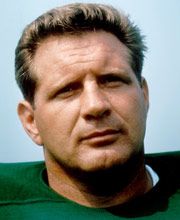
Jim Ringo
|
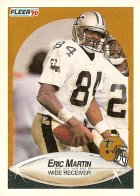
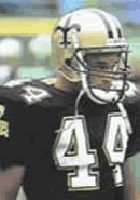
Dave Waymer
|
The Saints lost Jim Mora's debut as head coach in the first game of the 1986 season. Atlanta thumped the Saints in the Superdome 31-10. The next week brought a different outcome.
- The Green Bay Packers provided the opposition in the Superdome.
- The Saints not only won, 24-10, but set a franchise record with seven interceptions.
- The "Bayou Bomber," Bobby Hebert, connected with WR Eric Martin on a 72y touchdown only 1:32 into the game. Shortly afterwards, the two hooked up on an 84-yd pass play from the Saints nine that led to a Morten Andersen field goal and a 10-0 lead.
- New Orleans moved out 17-0 later in the first quarter on a 3y run by rookie Dalton Hilliard.
- The Saints led 24-3 at the half.
Two of the seven picks were by Dave Waymer. He had lost his six-year starting job to Willie Tullis at the opening of the season. However, Tullis missed practice Friday and Saturday, claiming he was sick. Since he hadn't checked with the team medical staff, he was replaced by Waymer.
Packer QB Randy Wright threw five of the interceptions while Vince Ferragamo accounted for the other two. S Russell Gary said:
We were hiding a lot of things, disguising the defenses well. A lot of times, it looked like we were in one thing and we were in something else.
The Saints finished Mora's maiden season 7-9, thanks in part to Hebert missing six weeks with a broken bone in his foot.
|
Best I've ever seen. Amazing. Thrives on pressure. Everything you look for. Just the best I've ever been associated with.
Those were the words of Saints GM Jim Finks describing Morten Andersen, a recent (11/2009) inductee into the Saints Hall of Fame. Jeff Duncan calls Mort "the greatest fourth-round draft pick in club history." (And, we might add, one of the best in NFL history.)
- A native of Denmark, Andersen had an outstanding career at Michigan State, including a Big Ten-record 63-yard field goal against Ohio State. Nevertheless, Saints fans were understandably skeptical when he was drafted - leery because of the Russell Erxleben debacle.
- We had all met Russell, and Andersen was no Erxleben - thank God! His left foot blasted his way into the team and NFL record books. He was a major weapon from 1982-1994, especially on Jim Mora's outstanding teams of the late 80s and early 90s.
- He tallied a staggering 1,318 points on 302 field goal and 412 PAT. All three numbers are still the most ever in team history.
- His field goal % was .776 (302-389).
- His longest field goal was 60 yd. He also booted a 56 yarder.
- Andersen is tied with Charlie Durkee for most field goals in a game with five. However, Durkee turned that trick only once while Morten did it four times.
Here are a few of the many highlights of Morten's career in the Crescent City.
- 1984: game winner vs Cleveland
- 1987: winner vs San Francisco
- Monday night, October 3, 1988: The Saints defeated Dallas 20-17 on Andersen's 49 yd field goal as time expired in the Superdome.
- In the last game of the '88 season, Andersen split the uprights from 30 yd out with five seconds remaining to defeat the Falcons 10-9. It was his seventh game-winner as a Saint.
- 1993: 49yd to beat the 49ers and 40 yd winner vs Falcons
Unfortunately, Saints fans' memories of Morten are bittersweet. The Saints released him just before the start of the 1995 season for salary cap purposes. Director of Business Administration at the time, Jim Miller, explains: "Keep in mind, the last two years Morten Andersen hadn't kicked very well. ... We saw him as a declining player."
To rub salt in the wounds, Mort signed with the hated Falcons and proceeded to make life miserable for his former team.
- In the fourth game of the '95 season, he booted four field goals, including the 21-yd winner in OT for a 27-24 victory over his former club.
- Three months later, he set an NFL record with three 50+ field goals in a 19-10 triumph over the Saints.
- Andersen played a total of eight seasons for Atlanta and holds that club's all-time scoring record also.
- He retired after the 2007 season.
Andersen holds the following NFL records.
- Most points career - 2,544
- Most games played - 382
- Most consecutive games scored - 360
- Most field goals - 565
- Most field goals attempted- 709
|

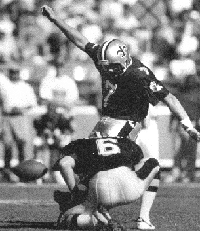
Morten Andersen in action
|
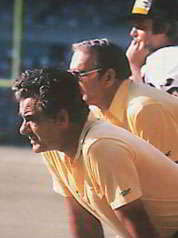
Dick Nolan
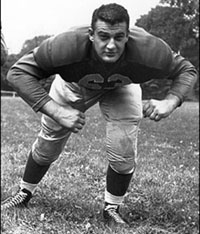
Dick Stanfel in his playing days
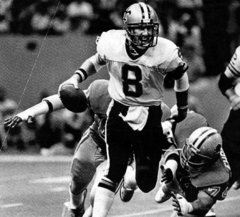
Archie Manning
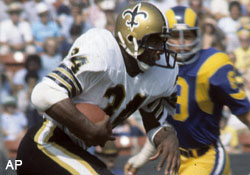
Tony Galbreath
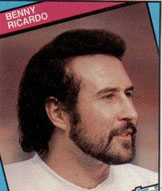
Benny Ricardo |
As this is written, the 2009 New Orleans Saints are 12-0. This article harkens back to a year when another Saints team also had a 0 in its won-loss record this late in the season. Only in 1980, the 0 was in the W column.
The 1979 Saints finished 8-8, the first time in the 13 seasons of the franchise that the team had won that many games and the first time with a .500 record. So there was reason for optimism for 1980 as Dick Nolan began his third season as head coach. To say that the hopes were dashed is an understatement.
- The 49ers edged the Saints in the Superdome 26-23 to start the season. Little did any one know that that would be the closest N.O. would come to victory for another 14 games.
- After the seventh defeat, a 41-14 thrashing at the hands of the Falcons, Jerry Gogreve walked into Charlie's Saints Marching Club Bar with a shopping bag over his head to hide both his embarrassment and his identity. Thus began the saga of the "Bagheads" as another patron in the bar, Robert LeCompte, painted a paper grocery bag gold and black and put the word "Aints" across the bottom. He then called his friend Buddy Diliberto, the popular N.O. sportscaster. When Buddy wore the bag during his telecast that night, he created an instant sensation. LeCompte ordered 5,000 "official" Aints bags and sold 3,000 at $1 each in a week.
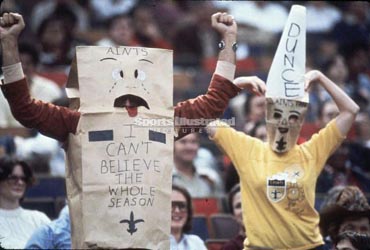
- The dwindling crowds at home games (only 30,936 for the 13th straight loss, to Minnesota) included numerous Bagheads. Newspaper wire services and network television told the story of the longsuffering Saints fans.
- A 27-7 Monday night home loss to the Los Angeles Rams cost Nolan his job. He was replaced by O line coach Dick Stanfel for the last four games. The team played better under Stanfel, losing to the Vikings only 23-20 and at San Francisco in OT 38-35.
Another loss and the Saints would exceed the 14 losses the winless Tampa Bay Buccaneers had suffered in 1976, their first year of existence. (The Bucs' futility reached 23 games the following season before they got their first victory over - who else? - the Saints.) However, fate finally smiled on the Saints in the second-to-last game at the New York Jets.
- "They weren't exactly storming Bourbon Street Sunday night, but at least New Orleans' fans could smile for the first time this season." That was how the UPI reporter started his article on the Saints' 21-20 victory over the 3-11 Jets.
- The wind gusted to 45 mph and the wind chill factor was 5. The AP writer described the scene thusly:
The setting was something you'd expect in an Edgar Allan Poe short story. There were leaden black skies hanging low over the stadium, winds swirling wildly, blowing sudden snow squalls madly around the park. It had started as a brisk, late-autumn afternoon with bright sunshine. But by midafternoon, it looked like the end of the world was approaching Shea Stadium.
- Trailing 13-7, New Orleans scored early in Q4 on Tony Galbreath's plunge and Benny Ricardo's PAT to take a one-point lead. The Jets retaliated when QB Richard Todd, a future Saint, bobbed and weaved his way 31-yd to paydirt. 20-14 New York with 9 1/2 minutes left.
- Archie Manning then guided the Saints 73 yd in 10 plays to retake the lead. Galbreath had two 9-yd runs and caught a pass for 11 yards during the winning drive, and the Saints' caught a break on a facemask penalty against the Jets. Jimmy Rogers raced 24 yards to the Jets' 7 and three plays later, Galbreath blasted over for his second touchdown of the game. Ricardo's kick put the visitors back up by one with 4:49 to play. Had the Saints scored too soon? No, the Jets were unable to get close enough for a field goal.
- The AP writer concluded:
Protesting New Orleans fans can throw away those paper bags they used to cover their faces, order up some barbecued shrimps, sit back with a praline or two and face the world once more. They ain't the Ain'ts no more.
- "I saw a comment in the papers that some of the Jets said it would be an embarrassment to lose to this team," Stanfel said in the clubhouse that resembled a Super Bowl locker room. "I told our guys it would be an embarrassment to lose to the Jets. We had a lot of adversity, but our guys fought it all the way through, and I'm proud of them."
Alas, the Saints couldn't extend their one-game winning streak in the last game, losing to New England 38-27 before only 38,277 in the Superdome. The 1-15 record remains the Saints worst ever.
|
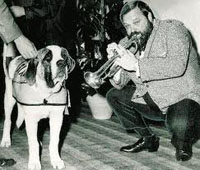
Original Gumbo with Al Hirt |
In their early days, the New Orleans Saints had a mascot named Gumbo, a St. Bernard. However, the dogs who played the role matched the woeful performance of the team.
- The original Gumbo was a gift from the Louisiana Restaurant Association. No doubt discouraged by the expansion team's lousy performance, the dog ran away.
- Gumbo II drank beer before each game and usually sat by the fence and whined to be let out. (Many fans behaved in a similar fashion.) He once chased a Pittsburgh Steelers' QB across the goal line for a touchdown. (Many Saints' defenders did this too.)
- The next Gumbo had to be dragged to work. After urinating on the field, he would curl up and go to sleep. (Again, reminiscent of many Saints' fans.)
- Gumbo IV made his mark by pooping on the field almost every game.
After all these difficulties, Gumbo was retired. In 1990, however, the NFL decreed that every team had to have a mascot. So Gumbo was resurrected, but not as a real dog. Instead, Gumbo became a human in a dog costume – presumably someone trustworthy enough not to repeat the mistakes of the canine predecessors.
|
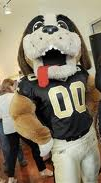
Gumbo Today |
Saints Get Moore from Lance
Almost every NFL team has someone like the Saints' Lance Moore – an undrafted player who makes a solid contribution. In Lance's case, teams should have paid more attention to the records he set in high school and college.
- As a senior at Westerville South High School, Moore set Ohio records with 103 receptions and 24 touchdown catches.
- At the University of Toledo, Lance broke numerous records.
- 15 catches in a game vs. Pittsburgh in 2003, including what Toledo refers to as "The Catch" – the game winner with 43 seconds left to upset the #9 Panthers 35-31
- Tied for 1st with 3 touchdowns receptions in a game (Pitt in 2003)
- 103 receptions in a season (2003; he is also second with 90 in 2004)
- 1,194 yards receiving in a season (2003; also second with 1,189 in 2004 making him the only player in Rocket history with two 1,000-yard seasons)
- 14 touchdown passes in a season (2004)
- 222 career receptions
- 2,776 pass receiving yards in a career (2001-4)
- 25 touchdown catches in a career
- Lance also gained 902 yards on 42 kickoff returns during his Toledo career, as well as 399 yards and two touchdowns on punt returns.
Despite his college performance, no team drafted Moore in 2005. Two reasons were given.
- He piled up his impressive numbers in non-BCS Mid-American Conference (MAC).
- He is only 5'9" and 190 lbs.
The nearby Browns signed him as a free agent but cut him at the end of training camp in 2005. The Saints signed him to their practice squad in late September that season, which they spent in San Antonio after Katrina.
Lance played with the Berlin Thunder in the 2006 (and last) season of NFL Europe. Then he got into four games for New Orleans in 2006. The next year, he appeared in all 16 games with four starts. He compiled 33 receptions for 312yd and 2 touchdowns. He also contributed as a return man – 17 KO returns for 318y and 26 punt returns for 230 in 2006-7.
After 13 games in 2008, Lance sports these stats.
62 catches, 774y, 8 touchdowns including a 70-yarder
Not bad for a guy that no team considered worth drafting in 2005.
Reference: New Orleans Saints Gameday Magazine, December 7, 2008
|
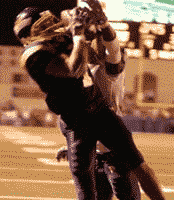 Lance Moore making "The Catch" at Toledo
Lance Moore making "The Catch" at Toledo
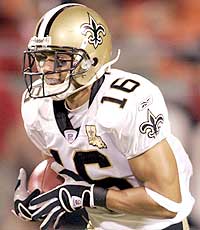
Lance Moore of the Saints
|
|
CONTENTS
First Draft
Dazzling Debut: Archie Manning
Dazzling Debut: John Fourcade
The Sad Tale of Russell Erxleben
Could've, would've, should've
Profile: Billy Kilmer
Interesting Story: "Shut that music off!"
Record Setter: Seven INTs
Profile: Morten Andersen
Memorable Game: Aints No More
Mascots to Fit the Team
Saints Get Moore from Lance
Saints Saga II
Saints Saga III
Saints Saga IV
Saints Saga V
Saints Saga VI
Saints Saga VII
Saints Saga VIII
Saints Saga IX - 1987
Football Magazine
Golden Rankings Home
Top of Page |
